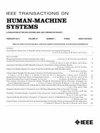A Single-Camera Method for Estimating Lift Asymmetry Angles Using Deep Learning Computer Vision Algorithms
IF 4.4
3区 计算机科学
Q2 COMPUTER SCIENCE, ARTIFICIAL INTELLIGENCE
引用次数: 0
Abstract
A computer vision (CV) method to automatically measure the revised NIOSH lifting equation asymmetry angle (基于深度学习计算机视觉算法的单摄像机升力不对称角估计方法
介绍了一种利用计算机视觉(CV)在单摄像机上自动测量修正后的NIOSH升降方程不对称角(A)的方法,并进行了测试。一项涉及10名参与者进行各种升降机的实验室研究被用来估计A与使用3-D运动捕捉(MoCap)获得的地面真实关节坐标的比较。为了解决现实场景中视野遮挡和摄像机位置限制等挑战,CV方法利用了一组选定地标的视频衍生坐标。二维姿态估计器(HR-Net)检测每个视频帧中的地标坐标,三维算法(VideoPose3D)通过分析每个二维地标的轨迹来估计其深度。与使用相同地标子集来估计A的动作捕捉测量相比,CV方法的平均绝对精度误差为6.25°(SD = 10.19°,N = 360)。与传统MoCap标记相比,CV方法的平均绝对精度误差为9.45°(SD = 14.01°,N = 360)。
本文章由计算机程序翻译,如有差异,请以英文原文为准。
求助全文
约1分钟内获得全文
求助全文
来源期刊

IEEE Transactions on Human-Machine Systems
COMPUTER SCIENCE, ARTIFICIAL INTELLIGENCE-COMPUTER SCIENCE, CYBERNETICS
CiteScore
7.10
自引率
11.10%
发文量
136
期刊介绍:
The scope of the IEEE Transactions on Human-Machine Systems includes the fields of human machine systems. It covers human systems and human organizational interactions including cognitive ergonomics, system test and evaluation, and human information processing concerns in systems and organizations.
 求助内容:
求助内容: 应助结果提醒方式:
应助结果提醒方式:


